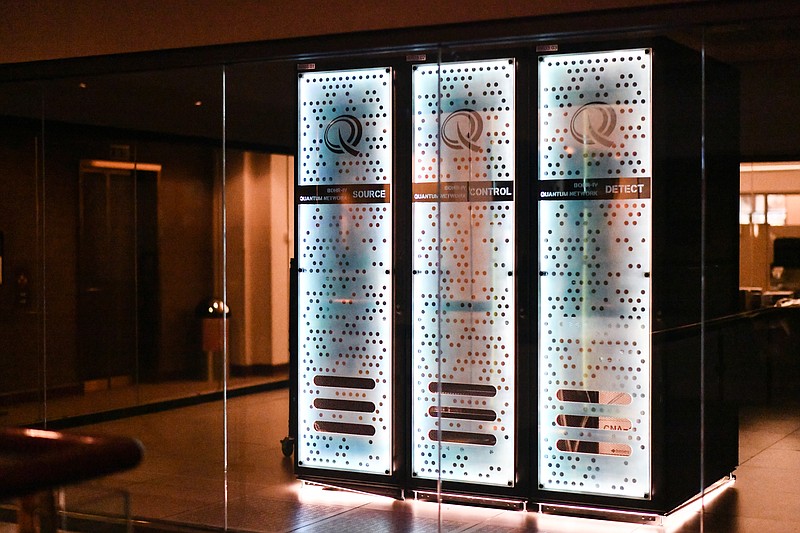Chattanooga's government and academic leaders appealed to researchers, entrepreneurs and academics in Washington, D.C., on Wednesday to come to Chattanooga to test their new computing, cybersecurity and other new technologies with the aid of the first commercial quantum network built on EPB's fiber optic connections.
EPB, the public utility that built the fastest citywide internet service in the Western Hemisphere using its fiber optic network, announced plans Wednesday to use those same fiber links to pioneer a new quantum network that could be the backbone for the next generation of the internet.
EPB and a San Diego-based research firm known as Qubitekk have been working over the past six years on a quantum cybersecurity network for the protection of the U.S. electric grid and now plan to expand the quantum network and open it to other users in the first-of-its-kind, communitywide service.
"Through our work, EPB and Qubitekk gained foundational expertise in how to establish and operate quantum networks as a real-world infrastructure," EPB Chairwoman Vicky Gregg said during an announcement Wednesday during the Quantum World Congress in Washington, D.C. "Our goal is to accelerate the private efforts of universities, private companies and other national research organizations to bring quantum technologies to market."
Gregg said the new EPB Quantum Network will provide quantum technologists with fiber optic infrastructure that integrates the latest foundational quantum equipment and software to help bring technologies to market.
Duncan Earl, president and chief technology officer at Qubitekk Inc., said quantum technologies represent a new frontier to exponentially advance cybersecurity, sensing and next-generation computing. U.S. spending on quantum technologies has already grown from $417 million in 2017 to more than $3 billion last year, and it is projected to continue to grow, Earl said.
Earl said the EPB Quantum Network can help bring different users together to identify new and better methods and uses for emerging technologies and services.
"If U.S. companies and researchers continue to develop quantum technologies in isolation, they face barriers such as the cost and time necessary to put together an end-to-end solution instead of focusing on their particular piece of the puzzle," Earl said during Wednesday's announcement of the new network. "This purpose-built infrastructure allows quantum technologists to run their solution collaboratively with other technologies while retaining their proprietary data and intellectual property."
Former Chattanooga Mayor and U.S. Sen. Bob Corker said quantum computing "is going to be front and center 20 years from now" and EPB's network should propel Chattanooga into a leadership role in the emerging technology of the future by lowering the barriers for private companies and researchers to develop quantum technologies and products.
"This is a monumental announcement for our country and our community to be a part of something that is bigger than ourselves," Corker said. "We are inviting companies from all over the United States to come to Chattanooga and make this work for America."
BUILDING GIG CITY
EPB began installing its fiber network across its 600-square-mile service territory in 2009 to help create a smarter electric grid and, in the process, also built a fiber communications network that is capable of delivering up to 25 gigabit-per-second internet speeds for a host of data and communication delivery options.
Chattanooga has billed itself as "the Gig City" since EPB created the first communitywide Gig internet service in 2010, and a University of Tennessee at Chattanooga study found EPB's fiber optic network has already generated nearly $2.7 billion in economic benefits and helped create nearly 10,000 additional jobs in Chattanooga.
The network also is able to share quantum bits of information, or qubits, that are the counterpart in quantum computing to the binary digit or bit in classical computing. Just as a bit is the basic unit of information in a classic computer, a qubit is the basic unit of information in a quantum computer. The EPB network has common-use equipment that is needed in quantum computing, communications and sensing.
EPB President David Wade said the utility has a node for the quantum network at EPB's downtown headquarters and another node about a mile away.
"We'll be adding a third node next summer," Wade said in a telephone interview Wednesday. "As the technology grows and we have folks come here and we get more users, we will continue to expand the network and allow it to grow as the technology, the usefulness and the demand warrants. I think we will see a lot of interest over the next few weeks and months from folks interested in this technology and coming to Chattanooga."
RECRUITING RESEARCH
Wade said EPB has already had some discussions with prospective quantum users, and both Chattanooga Mayor Tim Kelly and Hamilton County Mayor Weston Wamp, along with UTC Chancellor Steve Angle, were at the Quantum World Congress to help promote Chattanooga and recruit university and business researchers.
"Our region has a real opportunity to become the nation's next innovation and technology hub with potential for federal funding that would catalyze unprecedented levels of growth and create hundreds of new jobs in high-growth, high-wage sectors," Kelly said Wednesday.
Wamp, who called EPB "the most extraordinary public utility in America," said EPB's latest venture into quantum technologies is typical of how Chattanooga "punches way above its weight."
Angle said UTC, which already uses EPB's fiber optic network for a host of "smart city" programs and studies at the university's Center for Urban Informatics and Progress, is eager to prepare the workforce needed to support new quantum technology ventures.
"We're going to work very hard to help build a quantum ecosystem in our community that will be a magnet for talent and also helps drive the economy," Angle said.
BUILDING THE BACKBONE
Earl said EPB's quantum network is the first communitywide network of its type that is interconnected with more than 200 optical fibers with the capacity for major expansion.
"This is critical infrastructure that is badly needed by the quantum industry to accelerate the development, adoption and reach of these technologies," he said.
Quantum-based communications reproduce a naturally occurring phenomenon in which a pair of light particles, or photons, are linked or "entangled" such that any change in one of the photons is instantaneously mirrored by its twin even when they are separated by great distances.
EPB and Qubitekk have worked with the Oak Ridge National Laboratory since 2016 to use quantum technology to improve cybersecurity, and their project was recognized a year ago as one of the top research projects and a winner of an R&D 100 award. The Quantum Protected Network also was named a finalist this year for a 2022 Edison Award.
"This project shows how our effort to build partnerships among Oak Ridge National Laboratory, EPB and other technology-focused companies and organizations across the Tennessee Valley Technology Corridor can translate cutting-edge science into marketplace solutions," U.S. Rep Chuck Fleischmann , R-Tenn., said in a statement Wednesday.
Contact Dave Flessner at dflessner@timesfreepress.com or 423-757-6340. Follow him on Twitter @DFlessner1.

